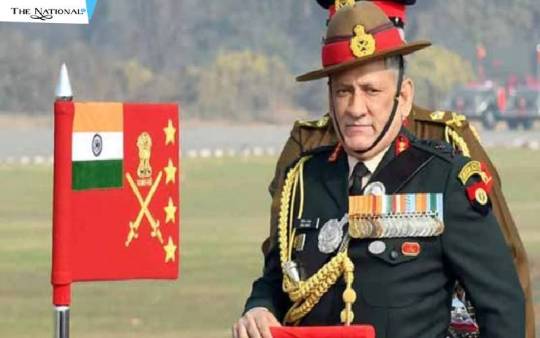#general bipin rawat
Explore tagged Tumblr posts
Text

General Bipin Rawat of the Indian Army meets a Japanese soldier of 34 Infantry Regiment at Itazuma, Japan, 2019
30 notes
·
View notes
Text
[ad_1] Paromita Das GG News Bureau New Delhi, 6th Jan. The Maha Kumbh Mela of 2025 is poised to be an extraordinary event, marking the culmination of 144 years since the last such gathering at Prayagraj. This sacred confluence of the Ganga, Yamuna, and the mythical Saraswati rivers has drawn sadhus, seers, and millions of pilgrims from around the world, all seeking spiritual transcendence through bathing in the holy waters and paying homage to the eternal Akshayvat tree. With its deep roots in Hindu scriptures and cultural traditions, the Maha Kumbh is more than a festival—it is a spiritual odyssey that transcends time, bringing together ancient wisdom and modern devotion. The Spiritual and Astronomical Significance of the Kumbh Mela The Maha Kumbh Mela is celebrated at intervals determined by precise astronomical alignments, reflecting a unique interplay of science and spirituality. According to Hindu scriptures, the Kumbh derives its sanctity from the celestial positioning of Jupiter in Taurus and the Sun in Capricorn, aligning to create a spiritually charged atmosphere. This convergence is not only an astronomical marvel but also a deeply symbolic event rooted in the story of the Samudra Manthan, where gods and demons churned the ocean to obtain Amrit (nectar of immortality). Drops of this divine nectar fell at four locations: Prayagraj, Haridwar, Ujjain, and Nashik, making these places eternal centers of spiritual energy. The Maha Kumbh at Prayagraj is the grandest of these gatherings, offering devotees the chance to cleanse their sins and attain moksha (liberation). Akshayvat: The Eternal Witness Central to the Maha Kumbh pilgrimage is the darshan of Akshayvat, the ancient banyan tree located near the Sangam. Revered as the “Indestructible Tree,” Akshayvat has been a silent witness to the cycles of creation and destruction described in Hindu cosmology. Hindu scriptures, including the Skanda Purana and Padma Purana, describe Akshayvat as a tree blessed by Mother Sita, who ensured its eternal vitality even during cosmic dissolution (Pralaya). This spiritual significance is further reinforced by legends of Lord Krishna resting on its leaves in his childhood form. Access to Akshayvat, restricted during the Mughal period, was restored in 2018 by Uttar Pradesh Chief Minister Yogi Adityanath. This effort was further amplified by visits from late General Bipin Rawat and Prime Minister Narendra Modi, highlighting the tree’s importance in Bharat’s spiritual and cultural heritage. The Historical Legacy of the Kumbh Mela The Maha Kumbh’s roots trace back to time immemorial, with mentions in the Rig Veda, Puranas, and even the Mahabharata. The Garuda Purana extols the spiritual benefits of bathing at the Sangam during the Kumbh, equating it to the merits of thousands of yajnas (sacrificial rituals). Historical records, including the travelogues of Chinese traveler Huen Tsang during Emperor Harshavardhan’s reign, provide vivid accounts of grand assemblies at the Sangam. Emperor Harsha is credited with organizing large fairs at Prayagraj, where he distributed his wealth to the poor and celebrated the spiritual significance of the confluence. The tradition of the Kumbh Mela continued through Bharat’s medieval and modern history, adapting to the changing times while retaining its core spiritual essence. The Maha Kumbh of 2025 is part of this continuum, offering a bridge between ancient traditions and contemporary spirituality. The Unique Grandeur of Maha Kumbh 2025 The Maha Kumbh Mela is distinguished from other Kumbh celebrations by its sheer scale and sanctity. While Poorna Kumbh occurs every 12 years and Ardh Kumbh every six, the Maha Kumbh at Prayagraj is an exceedingly rare event, occurring only when the celestial alignments mark a particularly auspicious moment. This year’s gathering is expected to draw millions of pilgrims, including international visitors, scholars, and spiritual seekers. Beyond its religious importance, the Maha
Kumbh serves as a cultural spectacle, showcasing Bharat’s artistic, musical, and culinary diversity. Temporary city-like arrangements, complete with tents, sanitation facilities, and healthcare, transform Prayagraj into a vibrant hub of devotion and community. The Role of Faith and Rituals The Maha Kumbh is not merely about bathing in the holy rivers—it is a comprehensive spiritual experience. Rituals like Ganga Aarti, discourses by spiritual leaders, and yoga sessions create an atmosphere of transcendence. Devotees perform pind daan (ancestral offerings) and partake in community prayers, emphasizing the event’s collective nature. Scriptures highlight the transformative power of bathing at the Sangam during the Kumbh. The Vishnu Purana states that one who bathes in the holy waters is freed from sins and attains closeness to Lord Vishnu. Similarly, the Mahabharata describes the Kumbh as a purifying event that cleanses the body and soul. A Cultural and Social Phenomenon While rooted in spirituality, the Maha Kumbh also serves as a platform for cultural exchange and social harmony. It brings together people from diverse backgrounds, fostering unity in a world often divided by borders and ideologies. The mela showcases Bharat’s resilience, its capacity to organize large-scale events, and its commitment to preserving heritage while embracing modernity. The Maha Kumbh is also a significant economic driver. Local businesses, artisans, and service providers benefit from the influx of pilgrims, while the government invests heavily in infrastructure, security, and sanitation. This holistic approach ensures that the event is not just a religious celebration but a catalyst for regional development. A Testament to Eternal Spirituality The Maha Kumbh of 2025 is a reminder of the timeless relevance of Bharat’s spiritual traditions. At a time when materialism and technology dominate global discourse, events like the Kumbh offer a counter-narrative, emphasizing inner peace, community, and the search for higher truths. However, the challenges of managing such a massive event cannot be ignored. Environmental concerns, crowd management, and logistical issues require careful planning and execution. Authorities must ensure that the sanctity of the event is preserved while accommodating the needs of millions of participants. Conclusion: The Maha Kumbh as a Symbol of Bharat’s Soul The Maha Kumbh Mela is more than an event—it is a reflection of Bharat’s spiritual essence and cultural diversity. As pilgrims gather at the Sangam to seek divine blessings, they reaffirm the values of faith, unity, and self-discovery that have defined Bharatiya civilization for millennia. In a rapidly changing world, the Maha Kumbh serves as a touchstone for continuity, reminding us of the enduring power of spirituality to unite, uplift, and inspire. As Prayagraj welcomes the world to its sacred shores, the Maha Kumbh of 2025 promises to be a momentous celebration of Bharat’s past, present, and eternal spirit. The post Sacred Waters and Eternal Faith: Maha Kumbh Returns to Prayagraj After 144 Years appeared first on Global Governance News- Asia's First Bilingual News portal for Global News and Updates. [ad_2] Source link
0 notes
Text
[ad_1] Paromita Das GG News Bureau New Delhi, 6th Jan. The Maha Kumbh Mela of 2025 is poised to be an extraordinary event, marking the culmination of 144 years since the last such gathering at Prayagraj. This sacred confluence of the Ganga, Yamuna, and the mythical Saraswati rivers has drawn sadhus, seers, and millions of pilgrims from around the world, all seeking spiritual transcendence through bathing in the holy waters and paying homage to the eternal Akshayvat tree. With its deep roots in Hindu scriptures and cultural traditions, the Maha Kumbh is more than a festival—it is a spiritual odyssey that transcends time, bringing together ancient wisdom and modern devotion. The Spiritual and Astronomical Significance of the Kumbh Mela The Maha Kumbh Mela is celebrated at intervals determined by precise astronomical alignments, reflecting a unique interplay of science and spirituality. According to Hindu scriptures, the Kumbh derives its sanctity from the celestial positioning of Jupiter in Taurus and the Sun in Capricorn, aligning to create a spiritually charged atmosphere. This convergence is not only an astronomical marvel but also a deeply symbolic event rooted in the story of the Samudra Manthan, where gods and demons churned the ocean to obtain Amrit (nectar of immortality). Drops of this divine nectar fell at four locations: Prayagraj, Haridwar, Ujjain, and Nashik, making these places eternal centers of spiritual energy. The Maha Kumbh at Prayagraj is the grandest of these gatherings, offering devotees the chance to cleanse their sins and attain moksha (liberation). Akshayvat: The Eternal Witness Central to the Maha Kumbh pilgrimage is the darshan of Akshayvat, the ancient banyan tree located near the Sangam. Revered as the “Indestructible Tree,” Akshayvat has been a silent witness to the cycles of creation and destruction described in Hindu cosmology. Hindu scriptures, including the Skanda Purana and Padma Purana, describe Akshayvat as a tree blessed by Mother Sita, who ensured its eternal vitality even during cosmic dissolution (Pralaya). This spiritual significance is further reinforced by legends of Lord Krishna resting on its leaves in his childhood form. Access to Akshayvat, restricted during the Mughal period, was restored in 2018 by Uttar Pradesh Chief Minister Yogi Adityanath. This effort was further amplified by visits from late General Bipin Rawat and Prime Minister Narendra Modi, highlighting the tree’s importance in Bharat’s spiritual and cultural heritage. The Historical Legacy of the Kumbh Mela The Maha Kumbh’s roots trace back to time immemorial, with mentions in the Rig Veda, Puranas, and even the Mahabharata. The Garuda Purana extols the spiritual benefits of bathing at the Sangam during the Kumbh, equating it to the merits of thousands of yajnas (sacrificial rituals). Historical records, including the travelogues of Chinese traveler Huen Tsang during Emperor Harshavardhan’s reign, provide vivid accounts of grand assemblies at the Sangam. Emperor Harsha is credited with organizing large fairs at Prayagraj, where he distributed his wealth to the poor and celebrated the spiritual significance of the confluence. The tradition of the Kumbh Mela continued through Bharat’s medieval and modern history, adapting to the changing times while retaining its core spiritual essence. The Maha Kumbh of 2025 is part of this continuum, offering a bridge between ancient traditions and contemporary spirituality. The Unique Grandeur of Maha Kumbh 2025 The Maha Kumbh Mela is distinguished from other Kumbh celebrations by its sheer scale and sanctity. While Poorna Kumbh occurs every 12 years and Ardh Kumbh every six, the Maha Kumbh at Prayagraj is an exceedingly rare event, occurring only when the celestial alignments mark a particularly auspicious moment. This year’s gathering is expected to draw millions of pilgrims, including international visitors, scholars, and spiritual seekers. Beyond its religious importance, the Maha
Kumbh serves as a cultural spectacle, showcasing Bharat’s artistic, musical, and culinary diversity. Temporary city-like arrangements, complete with tents, sanitation facilities, and healthcare, transform Prayagraj into a vibrant hub of devotion and community. The Role of Faith and Rituals The Maha Kumbh is not merely about bathing in the holy rivers—it is a comprehensive spiritual experience. Rituals like Ganga Aarti, discourses by spiritual leaders, and yoga sessions create an atmosphere of transcendence. Devotees perform pind daan (ancestral offerings) and partake in community prayers, emphasizing the event’s collective nature. Scriptures highlight the transformative power of bathing at the Sangam during the Kumbh. The Vishnu Purana states that one who bathes in the holy waters is freed from sins and attains closeness to Lord Vishnu. Similarly, the Mahabharata describes the Kumbh as a purifying event that cleanses the body and soul. A Cultural and Social Phenomenon While rooted in spirituality, the Maha Kumbh also serves as a platform for cultural exchange and social harmony. It brings together people from diverse backgrounds, fostering unity in a world often divided by borders and ideologies. The mela showcases Bharat’s resilience, its capacity to organize large-scale events, and its commitment to preserving heritage while embracing modernity. The Maha Kumbh is also a significant economic driver. Local businesses, artisans, and service providers benefit from the influx of pilgrims, while the government invests heavily in infrastructure, security, and sanitation. This holistic approach ensures that the event is not just a religious celebration but a catalyst for regional development. A Testament to Eternal Spirituality The Maha Kumbh of 2025 is a reminder of the timeless relevance of Bharat’s spiritual traditions. At a time when materialism and technology dominate global discourse, events like the Kumbh offer a counter-narrative, emphasizing inner peace, community, and the search for higher truths. However, the challenges of managing such a massive event cannot be ignored. Environmental concerns, crowd management, and logistical issues require careful planning and execution. Authorities must ensure that the sanctity of the event is preserved while accommodating the needs of millions of participants. Conclusion: The Maha Kumbh as a Symbol of Bharat’s Soul The Maha Kumbh Mela is more than an event—it is a reflection of Bharat’s spiritual essence and cultural diversity. As pilgrims gather at the Sangam to seek divine blessings, they reaffirm the values of faith, unity, and self-discovery that have defined Bharatiya civilization for millennia. In a rapidly changing world, the Maha Kumbh serves as a touchstone for continuity, reminding us of the enduring power of spirituality to unite, uplift, and inspire. As Prayagraj welcomes the world to its sacred shores, the Maha Kumbh of 2025 promises to be a momentous celebration of Bharat’s past, present, and eternal spirit. The post Sacred Waters and Eternal Faith: Maha Kumbh Returns to Prayagraj After 144 Years appeared first on Global Governance News- Asia's First Bilingual News portal for Global News and Updates. [ad_2] Source link
0 notes
Text

Send from Sansgreet Android App. Sanskrit greetings app from team @livesanskrit .
It's the first Android app for sending @sanskrit greetings. Download app from https://livesanskrit.com/sansgreet
General Bipin Rawat.
General Bipin Rawat PVSM UYSM AVSM YSM SM VSM ADC (16 March 1958 – 8 December 2021) was a four star general of the Indian Army. He was the first Chief of Defence Staff (CDS) of India. On 30 December 2019, he was appointed as the first CDS of India and assumed office from 1 January 2020. Prior to taking over as the CDS, he served as 57th and last Chairman of the Chiefs of Staff Committee as well as 26th Chief of Army Staff of the Indian Army.
#sansgreet #sanskritgreetings #greetingsinsanskrit #sanskritquotes #sanskritthoughts #emergingsanskrit #sanskrittrends #trendsinsanskrit #livesanskrit #sanskritlanguage #sanskritlove #sanskritdailyquotes #sanskritdailythoughts #sanskrit #resanskrit #celebratingsanskrit #bipinrawat #generalbipinrawat #rawat #Indianarmy #adgpi #indianarmyadgpi #Indianairforce #indiannavy #cds #pauri #uttarakhand #coonoor #madrasregiment #nationaldeffenceacademy
#greetingsinsanskrit#sanskritgreetings#sanskrittrends#trendsinsanskrit#livesanskrit#sanskrit#celebratingsanskrit#incredibleindia#indianarmy
0 notes
Text

Heartfelt tribute to India’s first Chief of Defence Staff, General Bipin Rawat, on his death anniversary. His exceptional leadership, strategic vision, and steadfast commitment to our nation’s security remain a guiding light for generations.
#SanjaySinha
1 note
·
View note
Text
Oshi Foundation pays tribute to General Bipin Rawat Bipin Rawat Jayanti is a significant occasion to commemorate the birth anniversary of General Bipin Rawat, who served as the Chief of the Army Staff of the Indian Army. It's a time to honor his contributions to the defense and security of the nation.
#BipinRawatJayanti#GeneralBipinRawat#IndianArmy#MilitaryLeader#DefenceDay#NationalSecurity#ArmyChief#ProudIndian#SaluteToSoldiers#BipinRawatLegacy#bhiwadi#donation#donate#csr#80g#charity#love#nonprofit#volunteer#help#education#giveback#ngo#support#community#fundraiser#children#fundraising#change#womenempowerment
1 note
·
View note
Text

Remembering the brave and visionary General Bipin Rawat 🙏🎖️
#Monteage#BipinRawat#RememberingAGreatLeader#GeneralBipinRawat#rememberinggeneralrawat#rawatlegacy#salutetobipinrawat#indianarmy#gonebutnotforgotten#honoringarealhero#foreverinourhearts
0 notes
Text

Meet India's New CDS General Bipin Rawat
Army Chief General Bipin Rawat has been appointed as the new Chief of Defence Staff by the government on Monday. With him being the CDS, smooth coordination among the army, air force and navy are expected to happen, as tri-services agencies on cyber and space came up during his tenure as the Army Chief. Importantly
0 notes
Text
0 notes
Text
0 notes
Text
0 notes
Text
0 notes
Text
[ad_1] GG News Bureau New Delhi, 9th Dec. Indian Army Vice Chief Lt General NS Raja Subramani paid tribute to the first Chief of Defence Staff (CDS) and longest-serving General, Bipin Rawat, on his third death anniversary on December 8 (Sunday). In his tribute, Lt General Subramani described General Rawat’s journey as a “masterclass in leadership.” The GBR Memorial Foundation of India organized a tribute program in Delhi on this solemn occasion. Lt General Subramani, along with Vice Admiral Atul Anand, Additional Secretary in the Department of Military Affairs, attended the event as special guests. Among the attendees were the President of the GBR Foundation of India, former Air Force Chief RKS Bhadauria, as well as Tarini Rawat, the daughter of the late General Bipin Rawat, and family members of other brave hearts. Speaking at the event, Lt General Subramani praised General Rawat as a “valiant patriot, a competent military strategist, and a leader par excellence.�� He reflected on General Rawat’s legacy, stating, “Today, we are commemorating the tragic loss of General Bipin Rawat. It’s been three years since we lost this valiant patriot, a competent military strategist, and a leader par excellence. Today’s event is a tribute to the imposing legacy of one of the greatest leaders and military professionals in the country. General Rawat was a scholar-soldier and a military reformer with an exceptional ability to envision the future.” He continued, “Known for his unwavering commitment to duty, razor-sharp strategic acumen, and extraordinary vision, the late General Rawat was more than a soldier. He was an institution in himself. His journey, filled with challenges and triumphs, is a masterclass in leadership.” Vice Admiral Atul Anand, Additional Secretary in the Department of Military Affairs, also spoke at the event. He shared his experience working with the late CDS, stating, “I had the privilege of witnessing his determined approach, result-oriented attitude, and exemplary leadership. I gained great insights into his thinking, which spanned from the tactical to the strategic level. His ideas encompassed bringing about change in the armed forces, civil-military relations, international relations, interservice relations, and much more.” Vice Admiral Anand further elaborated on General Rawat’s approach to military strategy, saying, “As Army Chief, he was very clear about the military’s strategic response on our western borders. He firmly believed that strong punitive action along the Line of Control and physical domination were the only ways to moderate our neighbor’s behavior.” General Bipin Rawat tragically passed away in a helicopter crash in December 2021. During his illustrious service, he was honored with PVSM, UYSM, AVSM, YSM, SM, VSM, and the Padma Vibhushan (posthumously). Remembering General Bipin Rawat General Rawat had a distinguished military career spanning four decades, gaining vast operational experience in the full spectrum of warfare. As a brigadier, he led successful counter-terrorism operations in Sopore and commanded a multinational brigade under the United Nations in the Democratic Republic of Congo. As a Major General, he commanded an Infantry Division along the Line of Control in North Kashmir. As Corps Commander, he oversaw the conduct of hot pursuit operations by the Indian Army’s Special Forces into Myanmar. Later, as Vice Chief of the Army Staff, he played a crucial role in overseeing the surgical strikes against Pakistan-based terrorist groups in PoK. His career was marked by numerous significant achievements and contributions to national security. The post Indian Army Vice Chief Pays Tribute to General Bipin Rawat on His Third Death Anniversary appeared first on Global Governance News- Asia's First Bilingual News portal for Global News and Updates. [ad_2] Source link
0 notes
Text
[ad_1] GG News Bureau New Delhi, 9th Dec. Indian Army Vice Chief Lt General NS Raja Subramani paid tribute to the first Chief of Defence Staff (CDS) and longest-serving General, Bipin Rawat, on his third death anniversary on December 8 (Sunday). In his tribute, Lt General Subramani described General Rawat’s journey as a “masterclass in leadership.” The GBR Memorial Foundation of India organized a tribute program in Delhi on this solemn occasion. Lt General Subramani, along with Vice Admiral Atul Anand, Additional Secretary in the Department of Military Affairs, attended the event as special guests. Among the attendees were the President of the GBR Foundation of India, former Air Force Chief RKS Bhadauria, as well as Tarini Rawat, the daughter of the late General Bipin Rawat, and family members of other brave hearts. Speaking at the event, Lt General Subramani praised General Rawat as a “valiant patriot, a competent military strategist, and a leader par excellence.” He reflected on General Rawat’s legacy, stating, “Today, we are commemorating the tragic loss of General Bipin Rawat. It’s been three years since we lost this valiant patriot, a competent military strategist, and a leader par excellence. Today’s event is a tribute to the imposing legacy of one of the greatest leaders and military professionals in the country. General Rawat was a scholar-soldier and a military reformer with an exceptional ability to envision the future.” He continued, “Known for his unwavering commitment to duty, razor-sharp strategic acumen, and extraordinary vision, the late General Rawat was more than a soldier. He was an institution in himself. His journey, filled with challenges and triumphs, is a masterclass in leadership.” Vice Admiral Atul Anand, Additional Secretary in the Department of Military Affairs, also spoke at the event. He shared his experience working with the late CDS, stating, “I had the privilege of witnessing his determined approach, result-oriented attitude, and exemplary leadership. I gained great insights into his thinking, which spanned from the tactical to the strategic level. His ideas encompassed bringing about change in the armed forces, civil-military relations, international relations, interservice relations, and much more.” Vice Admiral Anand further elaborated on General Rawat’s approach to military strategy, saying, “As Army Chief, he was very clear about the military’s strategic response on our western borders. He firmly believed that strong punitive action along the Line of Control and physical domination were the only ways to moderate our neighbor’s behavior.” General Bipin Rawat tragically passed away in a helicopter crash in December 2021. During his illustrious service, he was honored with PVSM, UYSM, AVSM, YSM, SM, VSM, and the Padma Vibhushan (posthumously). Remembering General Bipin Rawat General Rawat had a distinguished military career spanning four decades, gaining vast operational experience in the full spectrum of warfare. As a brigadier, he led successful counter-terrorism operations in Sopore and commanded a multinational brigade under the United Nations in the Democratic Republic of Congo. As a Major General, he commanded an Infantry Division along the Line of Control in North Kashmir. As Corps Commander, he oversaw the conduct of hot pursuit operations by the Indian Army’s Special Forces into Myanmar. Later, as Vice Chief of the Army Staff, he played a crucial role in overseeing the surgical strikes against Pakistan-based terrorist groups in PoK. His career was marked by numerous significant achievements and contributions to national security. The post Indian Army Vice Chief Pays Tribute to General Bipin Rawat on His Third Death Anniversary appeared first on Global Governance News- Asia's First Bilingual News portal for Global News and Updates. [ad_2] Source link
0 notes
Text

Send from Sansgreet Android App. Sanskrit greetings app from team @livesanskrit .
It's the first Android app for sending @sanskrit greetings. Download app from https://livesanskrit.com/sansgreet
General Bipin Rawat.
General Bipin Rawat PVSM UYSM AVSM YSM SM VSM ADC (16 March 1958 – 8 December 2021) was a four star general of the Indian Army. He was the first Chief of Defence Staff (CDS) of India. On 30 December 2019, he was appointed as the first CDS of India and assumed office from 1 January 2020. Prior to taking over as the CDS, he served as 57th and last Chairman of the Chiefs of Staff Committee as well as 26th Chief of Army Staff of the Indian Army.
#sansgreet #sanskritgreetings #greetingsinsanskrit #sanskritquotes #sanskritthoughts #emergingsanskrit #sanskrittrends #trendsinsanskrit #livesanskrit #sanskritlanguage #sanskritlove #sanskritdailyquotes #sanskritdailythoughts #sanskrit #resanskrit #celebratingsanskrit #bipinrawat #generalbipinrawat #rawat #Indianarmy #adgpi #indianarmyadgpi #Indianairforce #indiannavy #cds #pauri #uttarakhand #coonoor #madrasregiment #nationaldeffenceacademy
#greetingsinsanskrit#sanskritgreetings#sanskrittrends#trendsinsanskrit#livesanskrit#sanskrit#celebratingsanskrit#indianarmy
0 notes
Text
0 notes